Items
keywords is exactly
water
-
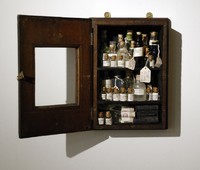
First Aid: Homage to Joseph Beuys
This work by the artist, Susan Hiller, consists of 13 vintage felt-lined wooden first aid boxes, 86 vintage bottles, water from holy wells and sacred streams, and vintage medical supplies. -
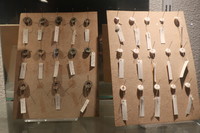
Buttons
A display of a collection of pins, buckles and buttons excavated from the washing pools used by slaves on Table Mountain. Taken from their dusty boxes in storage they are currently exhibited as part of Skotnes's 'Division of the World' (Department of Archaeology). -
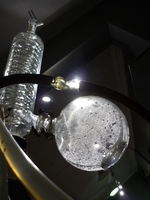
The experiment (Wine into water)
An experiment in three parts, reversing the first miracle. -

Planthology (detail)
“For 'Planthology (Bulbine frutescens and Lessertia frutescens)' I sourced two medicinal plant specimens from Kirstenbosch National Botanical Garden and x-rayed them at Groote Schuur Hospital (#10 and #13). These two local plants offer a wide variety of healing properties and address the lacuna of the chest. The fresh leaves of the Bulbine frutescens produce a jelly-like juice that can be used for burns, rashes, blisters, insect bites, cracked lips, acne, cold sores, mouth ulcers and areas of cracked skin, while an infusion of these leaves in a cup of boiling water can be taken for coughs, colds and arthritis (Harris 2003: online). The Lessertia frutescens is used as an immune booster in the treatment of HIV/AIDS, as a medicine in the treatment of chicken pox, internal cancers, colds, asthma, TB, bronchitis, rheumatism, rheumatoid arthritis and osteoarthritis, liver problems, haemorrhoids, piles, bladder and uterus problems, diarrhoea, dysentery, stomach ailments, heartburn, peptic ulcers, backache, diabetes, varicose veins and inflammation (Xaba & Notten 2003: online)” (Liebenberg 2021: 269). -

Measuring Niagara falls with a teaspoon
Georgian silver spoon drawn to the height of Niagara Falls. -

Vatnajökull (the sound of)
A live phone line was created to an Icelandic glacier, via an underwater microphone submerged in Jökulsárlón lagoon, an outlet of Vatnajökull. The number 07757001122 could be called from any telephone in the world, and the listener would hear the sound of the glacier melting. -

Condensation Cube
"One of Hans Haacke’s earlier works. While over time the artist developed a critique of art as an institution and system, these early works focus on art in the sense of process and physical system. Interested in biology, ecology and cybernetics, in the mid-sixties Haacke was influenced by the ideas of Ludwig von Bertalanffy, especially those outlined in his General System Theory of 1968. For the Austrian biologist and philosopher, a living organism is an open system that continuously changes depending on its dialogue or interaction with the environment. Haacke’s early works, such as Condensation Cube, transpose this concept to the realm of art" (MACBA 2021). -

Flood
Photo of water in Jagger Library by photographer, Lerato Maduna. On 18 April, the Jagger Library — the medicine chest's home — caught fire. The fire started on the lower sections of Rhodes Memorial at the foot of Table Mountain, and set alight landscape, monuments, and many of the university’s buildings. The library only caught fire in the late afternoon, but became a raging inferno as books, artworks, manuscripts that were worked on frequently, institutional, and administrative records of Special Collections, as well as the entire African Film collection, all went up in flames. -
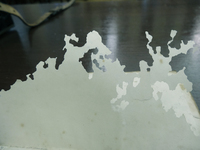
A wave crashing
A page from the BWC guide -

Perpetuum Mobile (2400KG)
Water, bucket, hydrophone, mist-machine, 2 400kg cement, relay timer, amplifier and cable. Water is set in motion by means of ultrasound (at times amplified by loudspeakers), generating steam that slowly spreads through the exhibition space and envelops sacks of cement whose mass is changed as the exhibition proceeds by the meandering atmospheric humidity. -

Silicosis
A gold miner using a rock drill with a water spray in an attempt to prevent the occupational disease silicosis, caused by dust inhalation. -

Forest (process)
A collection of Echinacea angustifolia tea rings read by botanist and dendrochronologist, Dr Edmund February. A molecule found in the Echinacea angustifolia plant prevents a caterpillar on eating it, from ever turning into a butterfly. Example of a specimen reading: “It would appear that the tree stood on a slope since there is more compression on the left hand side, which indicates that side was under less tension. It could also be a branch of which the left hand side would be its underside. The rings are uniformly wide which suggests plenty of soil and moisture availability. In comparison with the other two trees, the outer rings suggest less water or more competition.” -

Forest
A collection of Echinacea angustifolia tea rings read by botanist and dendrochronologist, Dr Edmund February. A molecule found in the Echinacea angustifolia plant prevents a caterpillar on eating it, from ever turning into a butterfly. Example of a specimen reading: “It would appear that the tree stood on a slope since there is more compression on the left hand side, which indicates that side was under less tension. It could also be a branch of which the left hand side would be its underside. The rings are uniformly wide which suggests plenty of soil and moisture availability. In comparison with the other two trees, the outer rings suggest less water or more competition.” -

Museum of Natural History Oxford
On a sunny afternoon, July 4th 1862, an Oxford don took out four friends, for a rowing expedition up the Thames. The don was the Oxford mathematician, photographer and storyteller, Charles Dodgeson (better known by his pen name, Lewis Carroll) and his friends were the Rev. Robinson Duckworth and three children – Alice Liddell, aged 10, and her sisters. During the afternoon Dodgeson spun out a series of fantastic yarns incorporating friends and familiar places in Oxford, mathematical riddles, literary allusions and countless references to natural history. -
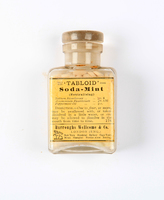
Soda-Mint (Neutralising)
"Antacid, exhilarant and stimulant. From one to three as a neutralising agent, in irritable and acid conditions of the stomach, dyspepsia, flatulence, etc. They may be swallowed with water, or be powdered and dissolved in water and taken as a draught" (BWC 1925:138). -
Quinine and Rhubarb Compound (Livingstone Rouser)
"Cathartic, tonic and anti-malarial. One to three may be taken with a little water, when an attack of malarial fever threatens, and repeated in two hours if necessary. Especially adapted for use as a purgative in the Tropics" (BWC 1925:136). The treatment, the Livingstone Rouser, was formulated by Dr Livingstone who, after an attack of malaria in 1853, patented this mixture of quinine and purgatives (calomel, rhubarb and jalop) mixed with opium. -
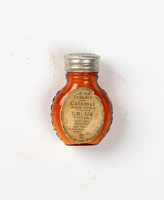
Calomel
"Alternative purgative. Use with caution. One to five of the smaller dose may be taken withh a draught of water as a cathartic and liver stimulant, or one, twice daily, as an alternative. The 5-grain dose is given in cases of jaundice accompanied by fever" (BWC 1925:122). -

Zinc Sulphate
"Astringent. One or two dissolved in an ounce of water, will be found useful as an eye-lotion, and as an injection or astringent lotion" (BWC 1925:144). -

Tannin
"Styptic. To stop bleeding, one or more may be pulverised, and the powder applied direct to the wound. Internally, for haemorrhage, and for dysentery, etc. One or two may be powdered and taken in a glass of water; or they may be slowly sucked of the effect be desired in the mouth or throat" (BWC 1925:140). -
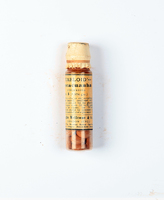
Ipecacuanha
"One thrice daily as an expectorant and diaphoretic, or for gastric irritation. In dysentery, four or more may be given with one 'Tabloid' Opium, gr.1; and four to six as an emetic in poisoning, etc. These 'Tabloid' products should be powdered and taken with a little water" (BWC 1925:129). -

Dover Powder
"Ipecacuanha with Opium. Anodyne, diaphoretic. Use with caution. One to three may be taken with a little water, on retiring, to break up a cold, or as an astringent, or for relief of pain" (BWC 1925:125) -
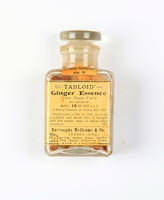
Ginger Essence
"Aromatic stimulant. One to two may be powdered and dissolved in a cup of hot water (with a little spirit if desired), and taken as a draught in colic, flatulence, etc., or as a stimulant" (BWC 1925:127). -
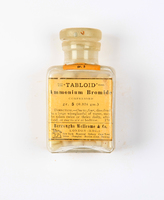
Ammonium Bromide
"Nerve sedative. One or two, dissolved in a wineglassful of water, three times a day, in hysteria, headache or neuralgia. As a sedative, four at bedtime " (BWC 1925:116). -

Hazeline (Witch Hazel)
"'Hazeline' brand witch hazel is prepared from the fresh young twigs of Hamamelis virginiana. It may be taken in doses of one to three teaspoonfuls, in water, for internal bleeding, or as an astringent in diarrhoea. Externally, it is of the highest value as an application, either plain or diluted with water, for piles and congested conditions of mucous membrane generally. It is the best application for cuts, abrasions, bruises and inflamed surfaces" (BWC 1925:128). -

Corrosive Sublimate
"Powerful antiseptic. Highly poisonous. Use with caution. Gr. 1.75 in four ounces, or gr. 8.75 in a pint of water, makes a solution of 1 in 1000, a useful strength for washing wounds, etc (BWC 1925:125). -
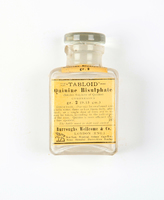
Quinine Bisulphate
"Anti-malarial, tonic. In malarial fevers, one or two should be taken every two hours. In ague, one to four should be taken, followed by a glass of water, and repeated in three hours if necessary" (BWC 1925:137). -

Compound of Tincture of Chloroform and Morphine
"Directions: For an adult, from five to ten minims may be taken in a wineglasful of water, and repeated in three to four hours, if necessary. In severe cases, the dose may be increased to fifteen minims. As this preparation contains potent posions, it should be used with caution". (As read on the lable of the bottle) "Action and Uses: In addition to its well-known use as an anaesthetic, Chloroform has been highly recommended for the relief of asthma, and in the form of vaporoles can be employed safely during the passage of calculi from the gall-bladder or kidney. The vaporoles are the most useful in obstetric practice. A vaporole may be crushed and the vapour inhaled from the palm of the hand" (BWC 1896: 38). "Morphine Sulphate: Anodyne. Use with caution. One swallowed gives great relief of pain"(BWC 1925:132). -

Iron and Arsenic Compound
"Tonic. Use with caution. One to two may be taken with a draught of water, three times daily, as a tonic during convalescence from malarial fevers, or as an alternative in skin affections" (BWC 1925:129) -
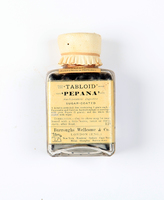
Pepana
"Digestive. One or two, swallowed whole, with a little water, after meals, in painful dyspepsia" (BWC 1925:134). -
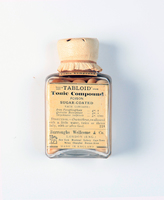
Tonic Compound
"Haematinic, tonic and stimulant. One to three, swallowed with a little water, twice or thrice daily, with or after food (BWC 1925:140).


